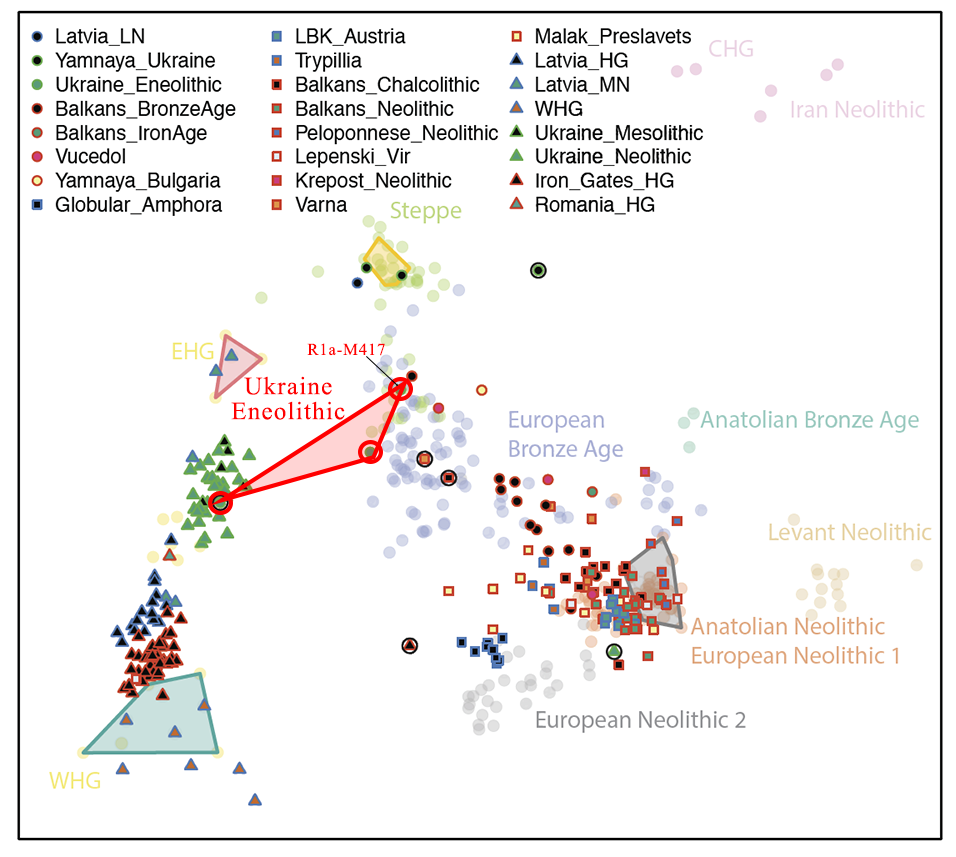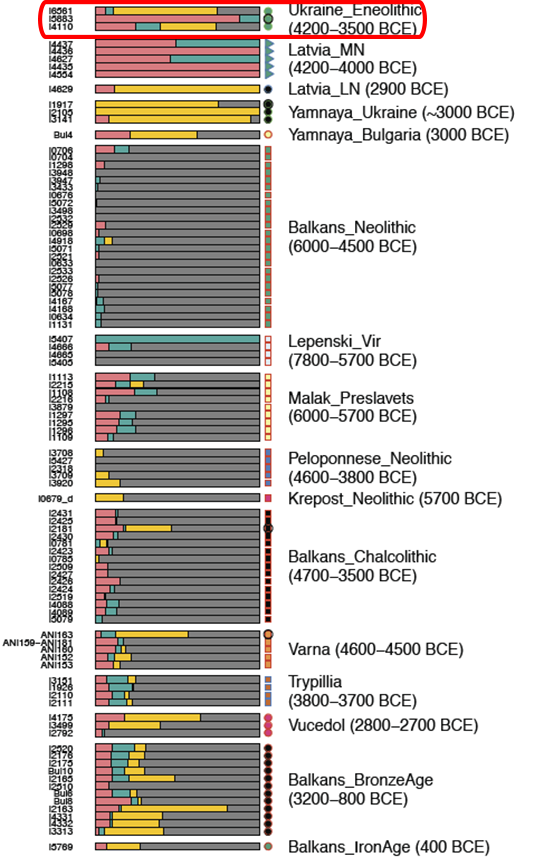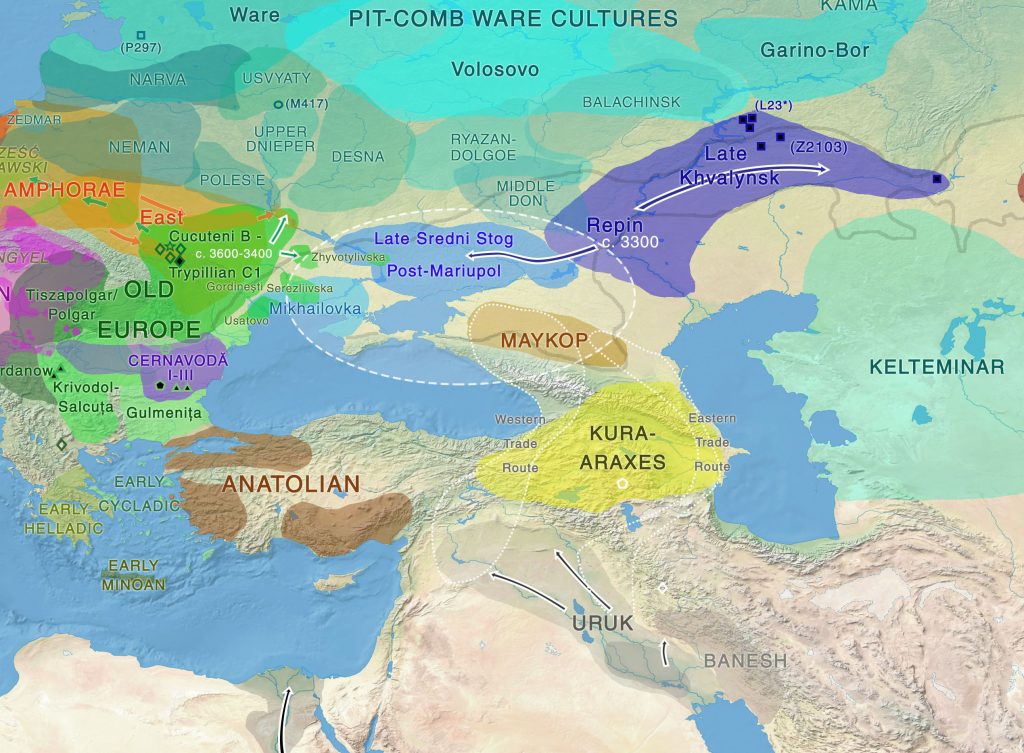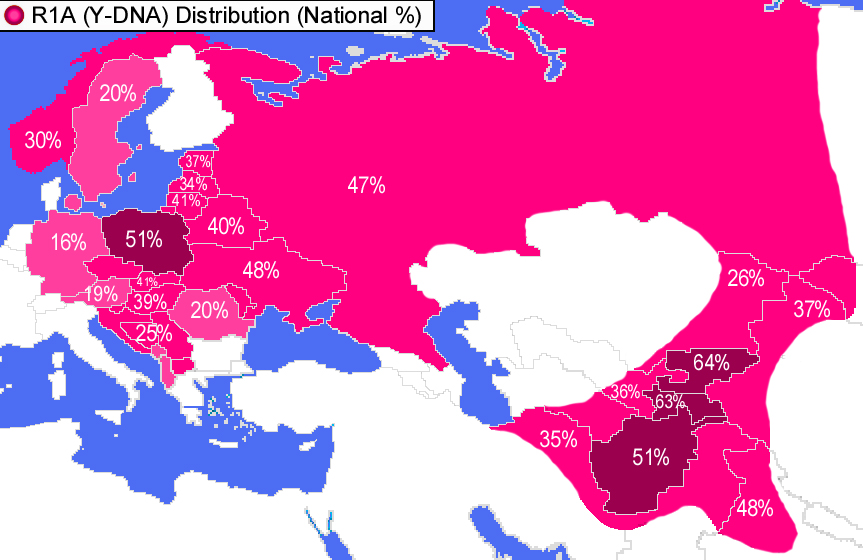Just one day after publishing the draft of the Indo-European demic diffusion model, 3rd version, Mathieson et al. (2017) have updated some information in a new version of their article, including a new interesting sample from late Sredni Stog. It gives support to what I predicted, regarding the potential origin of the third Corded Ware horizon.
After my first version, findings in Olalde et al. (2017) and Mathieson et al. (2017) supported some of my predictions. Now after my third, their new data also supports another prediction. Because the model is based on solid linguistic and archaeological models. Here is an excerpt from the Indo-European demic diffusion model, 3rd ed. (pp. 55-56):
At the end of the Trypillian culture, herding/hunting trends intensified, and the agricultural system collapsed, with people moving to the steppe zone, as confirmed by the presence of numerous graves to the south (Rassamakin 1999). At the same time, the Trypillian world absorbed a foreign tradition related to materials of settlement sites of the Dnieper steppes – such as the late Sredni Stog culture –, like cord impressions and burial rites similar to the later Corded Ware culture, marking also the transformation of decors and changes in their interpretation (Palaguta 2007).
The similarity in burial rituals between Yamna and Corded Ware made Gimbutas define a common “Kurgan people”, whose relationship has also been long supported by Kristiansen (Kristiansen 1989; Kristiansen et al. 2017). An equivalence of both burial rites has been, however, rejected (Häusler 1963, 1978, 1983), and it is generally agreed that the Yamna culture did not expand to the north of the Tisza River.
The importance of horse exploitation in Deriivka, in the forest-steppe zone of the north Pontic region along the Dnieper region, during the Middle Eneolithic period (probably ca. 3700-3530 BC), suggests that horses played a significant role in the life of this Sredni Stog community (Anthony and Brown 2003). In its late period (ca. 4000-3500 BC), this culture had adopted corded ware pottery, and stone battle-axes.
However, this [sic] western steppe peoples were mainly hunters (Rassamakin 1999), and the ‘herding skill’ essential for wild horse domestication seems absent (Kuzmina 2003). All this has been confirmed with zooarchaeological evidence and new molecular and stable isotope results, suggesting an absence of horse domestication in territories of the late Sredni Stog culture in the north Pontic steppe (Mileto et al. 2017), before the advent of migrants from the Indo-European-speaking Repin culture.
The new sample described in Mathieson et al. (2017), dated ca. 4200 BC (but within a wide range, 5000-3500 BC) is from a site classified as of late Sredni Stog (although potentially from Post-Mariupol / Kvitjana), a culture of hunters who probably did not breed domesticated horses (even after the period of conquest and dominance of Suvorovo-Novodanilovka chiefs, from Indo-Hittite-speaking early Khvalynsk, who had domesticated horses), and – more importantly – is of R1a-M417 lineage, shows high so-called “Yamna component” in ADMIXTURE, and clusters among Corded Ware samples in PCA approximately a thousand years before this culture’s expansion. Information from the supplementary material:
An Eneolithic cemetery of the Sredny Stog II culture was excavated by D. Telegin in 1955-1957 near the village of Alexandria, Kupyansk district, Kharkov region on the left bank of the river Oskol. A total of 33 individuals were recovered. Based on craniometric analysis (I.Potekhina 1999) it was suggested that the Eneolithic inhabitants of Alexandria were not homogeneous and resulted from admixture of local Neolithic hunter-gatherers and early farmers, possibly Trypillian groups. We report genetic data from one individual: I6561

Another individual from Eneolithic Ukraine (of R1b1 xM269 lineage) clusters quite closely with Neolithic samples from the Baltic, which points to the strong connection between both – southern and northern – regions of east-central Europe before the period of great Chalcolithic expansions, and the potential origin of the spread of R1b (xM269) lineages with the Corded Ware culture.
The so-called ‘Yamna component’ – an infamous name which, as expected, is turning out to be very wrong – has been found quite elevated in this sample, previous and completely unrelated to the Yamna culture and its expansion, and similar to the (later) Corded Ware samples. In fact, we are seeing that Corded Ware samples are actually clustering closely with east-central Europe (excluding the CWC outlier), and not with Yamna and other Indo-European-speaking steppe cultures.

It will be fun to see the mess that certain researchers have made (and will still make in the near future) of their findings coupled with the concept of “Yamna component”, when trying to describe the “proxy ancestral populations” of European Copper Age and Bronze Age cultures… Difficult times ahead for many, after the collapse of the simplistic Yamna -> Corded Ware -> Bell Beaker genetic model laid out since Haak et al. (2015) and Allentoft et al. (2015).
[EDIT 27 September 2017] Not directly related, but here is today’s interesting discussion on Twitter surrounding the ancestral populations of the “Yamnaya component”, for illustration of the discussions to come when this ancestry is divided into different, more precise, older (Neolithic) steppe components, and these in turn shown to contribute to different European and Asian Chalcolithic and Bronze Age cultures:
Rough attempt to understand genetic history of Europe and W. Eurasia. It's tough to get your head around. Comments welcome. pic.twitter.com/lutXFKmluk
— Graham Coop (@Graham_Coop) September 26, 2017
Given the variance found in the three samples from Eneolithic Ukraine (comparable to the variance found in east Bell Beaker samples), we may now be getting closer to the precise territory and culture where the Corded Ware culture might have formed, which cannot be much further from the Dnieper-Dniester region before the Yamna expansion to the west ca. 3300 BC, judging from the elevated steppe component.
It seems, because of the proximity of both cultures and the similar dates of their migrations, that the westward expansion of the Yamna culture may have indeed provided an important push (among some strong ‘pull’ forces) for peoples of the expansion of the Corded Ware culture.

It keeps being demonstrated that archaeologists like Anthony, Heyd, Mallory, etc. were right where others tried to interpret admixture based on few samples and their own imagination, without any knowledge (or interest) whatsoever about Archaeology or Linguistics.
So Genetics reinforces the solidest models of Archaeology and Linguistics? Professional academics being mostly right in their careful research, and amateur geneticists playing with software being wrong? Who would have thought… More and more papers help thus shut up naysayers who state (again and again) that new algorithms are here to revolutionise these academic fields.
As Heyd predicted more than 10 years ago, and as many pointed out in terms of linguistic influence (like Mallory or Prescott) the transformation of Yamna settlers into the east Bell Beaker culture, and this culture‘s spread into western and northern Europe, must be noticed in genetic investigation.
The expansion of peoples is known to be associated with the spread of a certain admixture component + the expansion and reduction in variability of a haplogroup (i.e. few male lineages are usually more successful during the expansion): Neolithic farmers from the Middle East expanding with haplogroup G2a; Natufian component (Levant hunter-gatherers or later, Neolithic farmers) and haplogroup E southward into Africa; CHG component expansion with haplogroup J; WHG expansion into east Europe with haplogroup R1b; etc.
There were (at least) two main expansion processes involving Proto-Indo-European: one causing the branching off of the language ancestral to Anatolian, and another during the spread of Late Indo-European dialects. Based on this, and on known archaeological models, I have predicted since the first version of the demic diffusion model:
- Based on haplogroups found until then in Yamna (R1b-M269), Corded Ware (R1a-M417, especially Z645), and Bell Beaker (R1b-L151):
- that mainly R1b-L23 (especially L51) lineages and more steppe admixture would be found in east Bell Beaker – confirmed some two months after my publication by Olalde et al. (2017);
- and that mainly R1a-M417 (especially Z645) subclades will be found in Corded Ware samples.
- Based on the finding of “Yamna component” in the Corded Ware culture: that this admixture must have come from somewhere else. I pointed out to eastern Europe, including the forest and forest-steppe zone especially in the natural continuum of the Dniester-Dnieper region. Especially after Mathieson et al. (2017), in my second and third versions of the model, I have more specifically suggested a southern origin in the region, nearer to where the CHG ancestry must have come from (the Caucasus and cultures formed in contact with it), according to mainstream archaeological data, i.e. cultures of the North Pontic steppe / steppe-forest. But of course, until more samples are available, more CHG ancestry in other cultures of the Forest Zone cannot be discarded.
For the vast majority of academics, more samples (regionally proportioned) are needed only from early Corded Ware, as we have from Bell Beaker: if they are (as expected) mostly R1a-M417, then everything is clear, and it will finally mean the end for the tiring, now almost ‘traditional’ association R1a – Proto-Indo-European. Some more samples from the potential homeland of the third Corded Ware horizon, most likely Ukraine (Podolia and Volynia regions), nearer to the time of the Corded Ware expansion, would also be great, to locate the actual ancestral population of Corded Ware migrants – recognisable by the main presence of haplogroup R1a-Z645 (formed ca. 3500 BC), and elevated “Yamna component” before the arrival of the Yamna culture…
If, however, early Corded Ware samples of R1b-L23 subclades are found in certain quantity, especially old samples from east-central Europe (excluding Yamna migrants along the Prut), the tricky question of Late Indo-European cultural diffusion will remain: Did Corded Ware peoples adopt a Late Indo-European language from clans of R1b-L23 lineages? That is what Kristiansen and Anthony have been betting for, a cultural diffusion, caused by:
- A long-lasting contact, according to Kristiansen (1989,…,2017). He defends that Sredni Stog adopted the language – but obviously not the same culture – from the east, but that it is a genetic and cultural mix from Globular Amphora, Trypillia, and steppe cultures. This has been Kristiansen’s model for almost 30 years, and it follows Marija Gimbutas’ outdated theory of the “Kurgan people”.
- A rapid change according to Anthony (2007). He associates the adoption of Pre-Germanic with the domination of Yamna chiefs over Usatovo people, and the adoption of Balto-Slavic by the people from (Corded Ware) Middle Dnieper group because of the technical superiority of neighbouring Yamna herders.
Linguistics, with the growing support of a North-West Indo-European group, points clearly to a European expansion of a community speaking the ancestral language of Italo-Celtic, Germanic, and probably Balto-Slavic. Archaeology, too, showed migration from Yamna only to south-eastern Europe (correcting Gimbutas’ Kurgan model) and later with east Bell Beaker mainly into central, western, and northern Europe.
Even Kristiansen admits that only after the arrival of Bell Beaker in Scandinavia was a linguistic community (i.e. Germanic) formed – although he places the center of gravity in Úněticean influence, and (yet again) a cultural diffusion event into the Danish Dagger period.
Because of more and more data contrasting with old theories, some have elected to develop weak, indemonstrable links, to keep supporting e.g. Gimbutas’ concept of “Kurgan people” in Archaeology, and a sudden, early expansion of all PIE dialects at once in Linguistics. It seems that, after so much fuss about the (misleading) ‘Yamna component’ concept – and so many far-fetched assumptions by amateur geneticists -, the Corded Ware connection will once again hinge on weak, indemonstrable cultural diffusion theories, be it ‘Kurgan peoples’ (including now, of course, Eneolithic cultures of Ukraine) or any culture from eastern Europe that will reveal some close samples to Corded Ware migrants, in terms of PCA, ADMIXTURE, or haplogroup.
So once we find mainly R1a-Z645 in more Corded Ware samples (and this haplogroup and more “Yamna component” in non-Yamna cultures of Eneolithic Ukraine, and potentially Poland or Belarus) we all may finally expect a peaceful acceptance of reality, at least in Genetics? Nope. No siree. Nein. Not then, not ever.
Why? Because some people want their paternal lineage to have lived in their historical region, and spoken their historical language, since time immemorial. It won’t matter if Archaeology, Linguistics, Genetics, etc. don’t support their claims: if they need to use some aspects of admixture, or haplogroups (or a combination of them) from carefully selected samples instead of looking at the whole picture; if they have to support that Indo-Europeans came from a culture different than Yamna, in- or outside of the steppe or forest-steppe, be it the Balkans, Anatolia, Armenia, or the Moon; if their proto-language should then come directly from Indo-Hittite, or from a Germano-Slavonic, or Indo-Slavonic, or Indo-Germanic group, or whatever invented dialectal branch necessary to fit their model, or if they have to support the ‘constellation analogy’ of Clackson, or thousands of years of development for each branch; etc. They will support whatever is necessary.
And this adaptation, obviously, has no end. It’s stupid, I know. But that’s how we are, how we think. We have seen that these sad trends continue no matter what, for decades, and not only regarding Indo-European. Some common examples include:
- Indo-Aryan-speaking Indians defending an autochthonous origin of R1a and Indo-European; as well as the ‘opposite’ autochtonous continuity theory of Dravidian-speaking Indians (based on ASI ancestry, haplogroup R2, mtDNA haplogroup M, or whatever is at hand).
- Western Europeans defending an autochthonous origin of the R1b haplogroup, with a Palaeolithic or Mesolithic origin, including the language, viz. the recent Indo-European from the Atlantic façade theories (in the Celtic from the West series, by Koch and Cunliffe); the now fading Palaeolithic Continuity Theory; and many other forgotten Eurocentric proposals; as well as the more recent informal hints of a central European/Balkan homeland based on the Villabruna cluster and south-eastern Mesolithic finds, which is at risk of being related to a Balkan origin of Proto-Indo-European…
- There is also the ‘opposite’ theory of the autochthonous origin of the Basques, including Proto-Iberians and potentially other peoples like Paleo-Sardinians, based on the previously popular Vasconic-Uralic hypothesis (and an ancient Europe divided into R1b and N1c1 haplogroups), which is still widely believed in certain regions.
- Finno-Ugric speakers of N1c1 lineage defending an autochtonous origin of the lineage and language in eastern Europe.
- Nordic speakers supporting the autochthonous nature of Germanic and haplogroup I1 to Scandinavia.
- Armenian speakers delighted to see a proposal of Indo-European homeland in the Armenian highlands, be it supported by glottalic consonants, CHG ancestrty, R1b (xM269) or J lineages…
- Greek speakers now willing to support continuity of haplogroup J as a ‘native’ Greek lineage, of people speaking Proto-Greek (and in earlier times PIE), because of two Minoan, and one Mycenaean samples found in Lazaridis et al. (2017).
- Even Turks linking Yamna with the expansion of Turkic languages. That one is fun to read, almost like a parody for the rest – substituting “Indo-European” for “Turkic”.
- For years, a lot of people – me included (at least since 2005) – believed, because of modern maps of R1a distribution, that R1a and Corded Ware are the vector of Indo-European languages. For those of us who don’t have any personal or national tie with this haplogroup, this notion has been easy to change with new data. For others, it obviously isn’t, and it won’t be.

For all these people, a sample, result, or conclusion from any paper, just dubiously in favour, means everything, but a thousand against mean nothing, or can be reinterpreted to support their fantasies.
The Kossinnian “autochthonous continuity” crap permeates this relatively new subfield of Human Evolutionary Genetics, as it permeated Indo-European studies (first Linguistics, then Archaeology) in its infancy. It seems to be a generalised human trend, no doubt related to some absurd inferiority complex, mixed with historical romanticism, a certain degree of chauvinism, and (falling in the eternal Godwin’s Law of our field) some outdated, childish notion of ‘supremacy’ linked with the expansion of the own language and people.
Such simplistic and popular models are also lucrative, judging by the boom in demand for DNA analysis, which companies embellish with modern fortune tellers (or fortune tellers themselves sell for a price), promising to ascertain your ‘ancestry proportions’ using automated algorithms, so that you don’t have to get lost in complex genetic data and prehistoric accounts, which can’t help you define your “ethnicity”…
Some just don’t want to realize that the spread of prehistoric languages (like Late Indo-European dialects) was a complex, non-uniform, stepped process, devoid of modern romantic concepts, which in genetic terms necessarily included later founder effects and cultural diffusions, so that no one can trace their haplogroup, lineage, family, region, or country to any single culture, language, or ethnic group. The same, by the way, can be said of peoples and countries in historic times.
As I said before, we shall expect supporters of the Kurgan model (and thus the expansion of R1a-Z645 with Yamna) to wait for just one sample of R1a-M417 in Yamna and/or Bell Beaker (which will eventually be found), and just one sample of R1b-M269 in Corded Ware (which will also eventually be found), to blow the horn of victory in this naïve competition against time, general knowledge, and (essentially) themselves.
A sad consequence of how we are is that, because of the obvious influence of these stupid modern ethnolinguistic agendas, because we are not all rowing in the same direction, genetic results and conclusions are still perceived as far-fetched and labile, and thus most archaeologists and linguists prefer not to include genetic results in their investigation. And those who dare to do so, are badly counselled by those who go with the tide, so that their papers become almost instantly outdated.
Related:
- The concept of “outlier” in studies of Human Ancestry, and the Corded Ware outlier from Erperstedt
- Heyd, Mallory, and Prescott were right about Bell Beakers
- Germanic–Balto-Slavic and Satem (‘Indo-Slavonic’) dialect revisionism by amateur geneticists, or why R1a lineages *must* have spoken Proto-Indo-European
- Something is very wrong with models based on the so-called ‘steppe admixture’ – and archaeologists are catching up